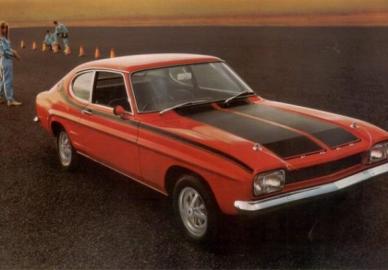Ford Capri

Specification
- Manufacturer Ford
- Production 1969-1974
- Assembly Dagenham, Halewood, United Kingdom
Genk, Belgium
Saarlouis, Cologne, Germany
Homebush, Australia - Body style(s) fastback coupé
- Class Mid-size sports car
- Engine(s) petrol:
V4 1.3L, 1.5L, 1.7L,
I-4 1.3L, 1.6L, 2.0L,
V6 2.0L, 2.6L, 3.0L, 3.1L, 3.4L - Transmission(s) Manual transmission
- Layout FR layout
The history of the Ford Capri
The first real Ford Capri was introduced in January 1969 at the Brussels Motor Show, with sales starting the following month. The intention was to reproduce the success of the North American Ford Mustang in Europe, to produce a European pony car. It was mechanically based on the Cortina and built in Europe at the Dagenham and Halewood plants in the UK, the Genk plant in Belgium, and the Saarlouis and Cologne plants in Germany.
The car was named Colt during development stage, but Ford were unable to use the name, as it was trademarked by Mitsubishi. Although a fastback coupe, Ford wanted the Capri MKI to be affordable for a large spectrum of potential buyers. In order to do that, it was available in a variety of engines. The British and German factories produced different line-ups.
The continental model used the Ford Taunus V4 engine in 1.3, 1.5 and 1.7 litre displacement, while the British versions were powered by the Ford Kent straight-4 in 1.3 and 1.6 litre form. The Cologne V6 2.0 L served as initial range-topper. Until the end of the year, new sports versions were added: the 2300 GT in Germany, using a double-barrel carburettor and 125hp (92 kW), and the 3000 GT in the UK, with the Essex V6, capable of 138 hp (103 kW).
Under the new body, the running gear would have been familiar to anyone used to working on the underside of a 1966 Cortina. Rear suspension employed a live axle supported on leaf springs with short radius rods. MacPherson struts featured at the front in combination with rack and pinion steering which employed a steering column that would collapse in response to a collision.
The range continued be broadened, with another 3.0 variant, the Capri 3000E introduced from the British plant in March 1970, offering "more luxurious interior trim".
In April 1970, Ford began selling the Capri outside Europe, in the North-American, South African and Australian markets. These versions were powered solely by the underpowered Kent 1.6 engine, but a Pinto straight 4 cylinder 2.0lt replaced it in 1971. The American version featured new headlights and bumpers, and carried no brand badge. A new 2637 cc version of the Cologne V6 appeared in September 1971, powering the Capri RS2600. This model used KŁgelfischer fuel injection to raise power to 150 hp (110 kW), and was the basis for the Group 2 RS2600 used in the European Touring Car Championship.
The very first Ford Special, was the Capri Vista Orange Special. The Capri Special was launched in November 1971 and was based on the 1600 GT, and 2000 GT models. It was only available in Vista orange and was dealer fitted with a boot mounted spoiler and rear window slats - a direct link to the Mustang. The Special also had some additional optional extras such as a pushbutton radio, fabric seat upholstery and inertia reel seat belts. Heated rear screen and black vinyl roof. There were only 1200 Vista Orange Capri specials made. One of the last limited editions of the original Mk1, was a version that came in either Metallic Green or black with Red interior and featured some additional extras, such as cloth inserts in the seats, hazard lights, map reading light, opening rear windows, vinyl roof and for the first time a bonnet bulge was fitted to the sub-3.0 litre models. This special edition was only available with a 1.6 or 2.0 engines and had the full title of GTXLR Special.
The Capri proved highly successful, with 400,000 cars sold until 1970. Ford revised it in 1972 to become what is known by enthusiasts as the Capri "Bis" or, in the UK, the "Mark 1 facelift" Capri. The car received a new and more comfortable suspension, rectangular headlights, enlarged tail-lights and new seats. The Kent engines were replaced by the Ford Pinto engine and the previously UK-only 3000 GT joined the German lineup. In the UK the 2.0 L V4 remained in use.
1973, saw the highest sales total the Capri ever attained, at 233,000 vehicles: the 1,000,000th Capri, an RS 2600, was completed on 29 August.
Ford for sale
- Ford Capri
-
1983 Nottinghamshire
 GBP200Trade sale Views: 8366
GBP200Trade sale Views: 8366 - Ford Capri
-
1973 Lancashire
 GBP2,400Private sale Views: 11114
GBP2,400Private sale Views: 11114 - Ford Capri
-
1987 Northamptonshire
 GBP2,500Private sale Views: 12058
GBP2,500Private sale Views: 12058 - Ford Capri II
-
1977 London
 GBP3,250Private sale Views: 7858
GBP3,250Private sale Views: 7858 - Ford Capri III
-
1984 Hertfordshire
 GBP1,200Private sale Views: 14905
GBP1,200Private sale Views: 14905 - Ford Capri III
-
1987 West Sussex
 POAPrivate sale Views: 10086
POAPrivate sale Views: 10086











